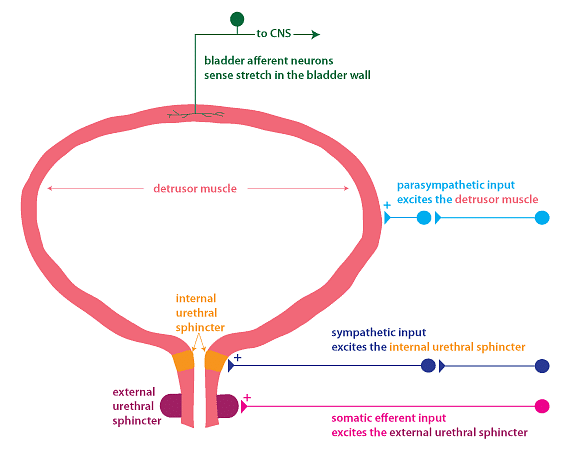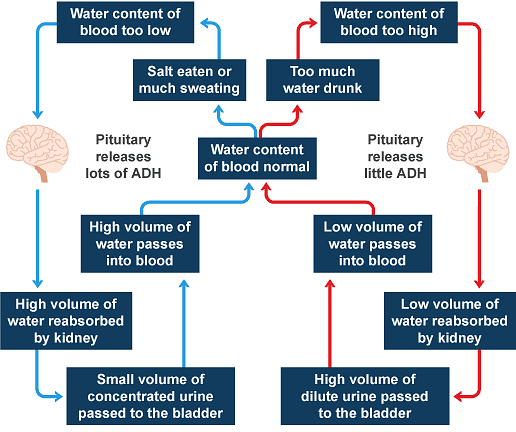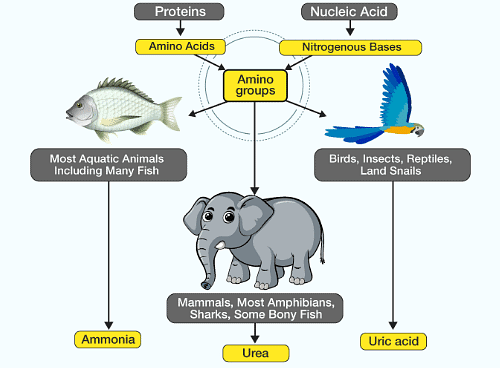Excretory Products & their Elimination NCERT Solutions | Biology Class 11 - NEET PDF Download
Q1: Define Glomerular Filtration Rate (GFR)
Ans: Glomerular filtration rate is the amount of glomerular filtrate formed in all the nephrons of both the kidneys per minute. In a healthy individual, it is about 125 mL/minute. Glomerular filtrate contains glucose, amino acids, sodium, potassium, urea, uric acid, ketone bodies, and large amounts of water.
 Fig: Glomerular Filtration Rate
Fig: Glomerular Filtration Rate
Q2: Explain the autoregulatory mechanism of GFR.
Ans: The mechanism by which the kidney regulates the glomerular filtration rate is autoregulative. It is carried out by the juxtaglomerular apparatus.
 Fig: Glomerular Filtration rate
Fig: Glomerular Filtration rate
Juxtaglomerular apparatus is a microscopic structure located between the vascular pole of the renal corpuscle and the returning distal convoluted tubule of the same nephron.It plays a role in regulating the renal blood flow and glomerular filtration rate. When there is a fall in the glomerular filtration rate, it activates the juxtaglomerular cells to release renin. This stimulates the glomerular blood flow, thereby bringing the GFR back to normal. Renin brings the GFR back to normal by the activation of the reninangiotensin mechanism.
Q3: Indicate whether the following statements are true or false:
(a) Micturition is carried out by a reflex.
(b) ADH helps in water elimination, making the urine hypotonic.
(c) Protein-free fluid is filtered from blood plasma into the Bowman’s capsule.
(d) Henle’s loop plays an important role in concentrating the urine.
(e) Glucose is actively reabsorbed in the proximal convoluted tubule.
Ans: (a) True
(b) False
(c) True
(d) True
(e) True
Q4: Give a brief account of the counter current mechanism.
Ans:
- The counter current mechanism operating inside the kidney is the main adaptation for the conservation of water. There are two counter current mechanisms inside the kidneys. They are Henle’s loop and vasa rectae.
- Henle’s loop is a U-shaped part of the nephron. Blood flows in the two limbs of the tube in opposite directions and this gives rise to counter currents. The Vasa recta is an efferent arteriole, which forms a capillary network around the tubules inside the renal medulla.
 Fig: counter current mechanism
Fig: counter current mechanism
- It runs parallel to Henley’s loop and is U-shaped. Blood flows in opposite directions in the two limbs of vasa recta. As a result, blood entering the renal medulla in the descending limb comes in close contact with the outgoing blood in the ascending limb.
- The osmolarity increases from 300 mOsmolL -1 in the cortex to 1200 mOsmolL -1 in the inner medulla by counter current mechanism. It helps in maintaining the concentration gradient, which in turn helps in easy movement of water from collecting tubules. The gradient is a result of the movement of NaCl and urea.
Q5: Describe the role of liver, lungs and skin in excretion.
Ans: Liver, lungs, and skin also play an important role in the process of excretion.
Role of the liver:
Liver is the largest gland in vertebrates. It helps in the excretion of cholesterol, steroid hormones, vitamins, drugs, and other waste materials through bile. Urea is formed in the liver by the ornithine cycle.
 Fig: liver
Fig: liver
Ammonia – a toxic substance – is quickly changed into urea in the liver and thence eliminated from the body. Liver also changes the decomposed haemoglobin pigment into bile pigments called bilirubin and biliverdin.
Role of the lungs:
Lungs help in the removing waste materials such as carbon dioxide from the body.
 Fig: Role of the lungs
Fig: Role of the lungs
Role of the skin:
Skin has many glands which help in excreting waste products through pores. It has two types of glands – sweat and sebaceous glands. Sweat glands are highly vascular and tubular glands that separate the waste products from the blood and excrete them in the form of sweat. Sweat excretes excess salt and water from the body. Sebaceous glands are branched glands that secrete an oily secretion called sebum.
Q6: Explain micturition.
Ans: Micturition is the process by which the urine from the urinary bladder is excreted. As the urine accumulates, the muscular walls of the bladder expand. Fig: MicturitionThe walls stimulate the sensory nerves in the bladder, setting up a reflex action. This reflex stimulates the urge to pass out urine. To discharge urine, the urethral sphincter relaxes and the smooth muscles of the bladder contract. This forces the urine out from the bladder. An adult human excretes about 1 – 1.5 litres of urine per day.
Fig: MicturitionThe walls stimulate the sensory nerves in the bladder, setting up a reflex action. This reflex stimulates the urge to pass out urine. To discharge urine, the urethral sphincter relaxes and the smooth muscles of the bladder contract. This forces the urine out from the bladder. An adult human excretes about 1 – 1.5 litres of urine per day.
Ques 7: Match the items of column I with those of column II:
Ans:
Q8: What is meant by the term osmoregulation?
Ans:
 Fig: osmoregulation
Fig: osmoregulation
Osmoregulation is a homeostatic mechanism that regulates the optimum temperature of water and salts in the tissues and body fluids. It maintains the internal environment of the body by water and ionic concentration.
Q9: Terrestrial animals are generally either ureotelic or uricotelic, not ammonotelic, why?
Ans: Terrestrial animals are either ureotelic or uricotelic, and not ammonotelic. This is because of the following two main reasons:
 Fig: Excretion in animals
Fig: Excretion in animals
- Ammonia is highly toxic in nature. Therefore, it needs to be converted into a less toxic form such as urea or uric acid.
- Terrestrial animals need to conserve water. Since ammonia is soluble in water, it cannot be eliminated continuously. Hence, it is converted into urea or uric acid. These forms are less toxic and also insoluble in water. This helps terrestrial animals conserve water.
Q10: What is the significance of juxtaglomerular apparatus (JGA) in kidney function?
Ans: Juxtaglomerular apparatus (JGA) is a complex structure made up of a few cells of glomerulus, distal tubule, and afferent and efferent arterioles. It is located in a specialised region of a nephron, wherein the afferent arteriole and the distal convoluted tubule (DLT) come in direct contact with each other. The juxtaglomerular apparatus contains specialised cells of the afferent arteriole known as juxtaglomerular cells. These cells contain the enzyme renin that can sense blood pressure. When glomerular blood flow (or glomerular blood pressure or glomerular filtration rate) decreases, it activates juxtaglomerular cells to release renin.
 Fig: JGA
Fig: JGA
Renin converts the angiotensinogen in blood into angiotensin I and further into angiotensin II. Angiotensin II is a powerful vasoconstrictor that increases the glomerular blood pressure and filtration rate. Angiotensin II also stimulates the adrenal cortex of the adrenal gland to produce aldosterone. Aldosterone increases the rate of absorption of sodium ions and water from the distal convoluted tubule and the collecting duct. This also leads to an increase in blood pressure and glomerular filtration rate. This mechanism, known as renin-angiotensin mechanism, ultimately leads to an increased blood pressure.
Q11: Name the following:
(a) A chordate animal having flame cells as excretory structures
(b) Cortical portions projecting between the medullary pyramids in the human kidney
(c) A loop of capillary running parallel to the Henle’s loop.
Ans: (a) Amphioxus is an example of a chordate that has flame cells as excretorystructures. Flame cell is a type of excretory and osmoregulatory system.
(b) The cortical portions projecting between the medullary pyramids in the humankidney are the columns of Bertini. They represent the cortical tissues present within the medulla.
(c) A loop of capillary that runs parallel to Henle’s loop is known as vasa rectae. Vasarectae, along with Henle’s loop, helps in maintaining a concentration gradient in the medullary interstitium.
Q12: Fill in the gaps:
(a) Ascending limb of Henle’s loop is ____________to water whereas the descending limb is ___________ to it.
(b) Reabsorption of water from distal parts of the tubules is facilitated by hormone____________.
(c) Dialysis fluid contains all the constituents as in plasma except ________.
(d) A healthy adult human excretes (on an average) _______ gm of urea/day.
Ans:
(a) Ascending limb of Henle’s loop is impermeable to water, whereas the descendinglimb is permeable to it.
(b) Reabsorption of water from distal parts of the tubules is facilitated by the Hormone vasopressin.
(c) Dialysis fluid contains all the constituents as in plasma, except the nitrogenous wastes.
(d) A healthy adult human excretes (on an average) 25 - 30 gm of urea/day.
|
181 videos|361 docs|148 tests
|
FAQs on Excretory Products & their Elimination NCERT Solutions - Biology Class 11 - NEET
| 1. What are the excretory products produced by the human body? |  |
| 2. How are excretory products eliminated from the body? |  |
| 3. What are the organs involved in the excretory system of humans? |  |
| 4. How do the kidneys help in the elimination of waste products? |  |
| 5. What role do hormones play in the excretory system? |  |

|
Explore Courses for NEET exam
|

|


















